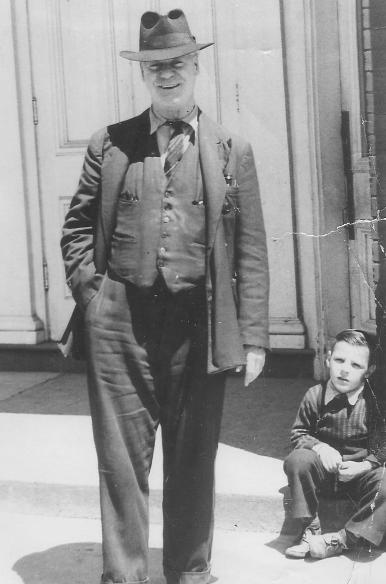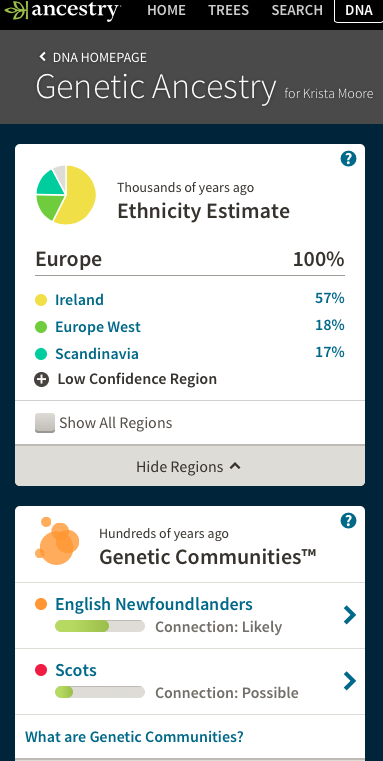In my wondrous “exploits” in my mother’s “native” home, Botwood, Newfoundland, I discovered something I never thought or even imagined in my family line. Aboriginal blood. But not just that – a tie to history so strong, so foreign to my North American, 5th generation sensibilities, that it broke through the barrier of my very idea of myself.
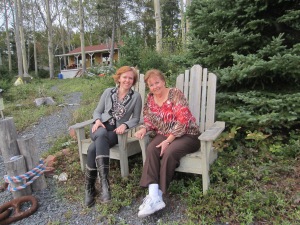
Krista Moore & mother Mary Moore (Hart) along Exploits, Nfld
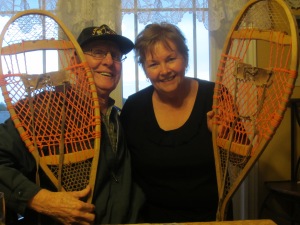
Gerald “Bud” Beaton & my mother Mary Moore (Hart)
Mixed Feelings on Learning the Truth
What does it mean to be part Mi’Kmaq or native? Apparently, many previous generation Newfoundlanders were ashamed of finding any native connection, and strove to hide it from their progeny, even going so far as to destroy family history documents (my mother not included in that mixture).
Now, perhaps due to more enlightened and inclusive times, or the Canadian government’s offering the with native heritage status and benefits, the next generation cousins have come forward to label themselves most proudly with this new reality of being “part native”. It seems we have not only come to terms with, but embrace the idea of our Mi’Kmaq heritage. And perhaps, ironically, are a little ashamed of our British ancestors for so brutally placing themselves in the midst of a great people, and obliterating most if not all of the Beothuks in the process.
Who are the Mi’Kmaq?

The Mi’Kmaq are a First Nations indigenous people from the Canadian Maritime provinces and Gaspé peninsula of Quebec, distantly related to the Algonquin. The Beothuk were have related DNA to the Mi’Kmaq, though they treated each other as separate, and were sometimes antagonistic to each other.
In the times when Mary Beaton lived, the early 1800s, both tribes were either in conflict with the British invaders, sometimes stealing their goods, or learned to become allies and helpers of the British in order to trade for weapons and other instruments, while teaching the British how to trap, survey, survive and master their new environment.
I am not an expert on Newfondland history, and so I write this from a purely ignorant but interested third-party “mainland” perspective, one who is tied by genetics, and is somewhat dependent on local hearsay or legend.
The Legend of Mary Beaton & The Last Beothuk
Mary Beaton, as far as we know, was a young Mi’Kmaq girl “who belonged to no one” and became a servant (willing or unwillingly?) in Captain John Peyton Jr.’s house during the 1820s, when the British were having troubled relations with the Beothuks, along the Exploits River in Newfoundland. Captain Peyton Jr., a magistrate, was trying to “make good” on some of the injustices and poor publicity caused by his father John Peyton Sr. Many intermarried as they were taken in by the European settlers, including our Mary Beaton to my great great great grandfather, James Gill of Dorset, England.
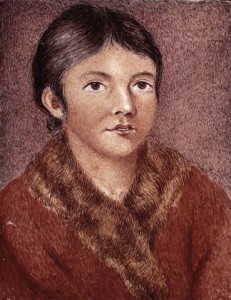
Shawnadithit Nancy – The Last Beothuk
One thing we do know, according to Mary Beaton Gill’s own son, John Henry Gill, who was interviewed in a book entitled: “River Lords, Father and Son: The Story of the Peytons and the River Exploits, 2nd ed.” by Amy Louise Peyton, his mother Mary would read to her children on cold nights about the time she spent in Mr. Peyton’s house as a servant with one of the last Beothuks, “Shawnadithit Nancy”, another aboriginal young woman, who was captured and saved during an altercation with her tribe in which one man was shot and another, her aunt, Demasduwit “Mary March” died shortly after capture.
Mary then married James Gill in the early 1830s, and they had their first child, Charles Beaton Gill, my great great grandfather around 1830 in Kite Cove, Newfoundland. Seven more Gill children followed.
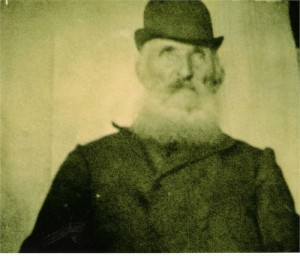
Charles Beaton Gill, b. 1830, Newfoundland
Legend & Proof
Recently, two pictures surfaced on the internet which have not been confirmed to be Mary and James Gill. However, I include them here to stimulate the imagination, and provoke further study and correction or confirmation. If you have any information on the origin of these pictures, or any other relevant documents, please forward to me using the Contact tab above.

Attributed to James Gill of Newfoundland, b. 1799 in Wimborne, Dorset, England, d. Newfoundland. m. Mary Beaton. Unconfirmed origin and likeness.

Attributed to “Mary Arder Gill”, an incorrect name and possibly mistaken for a woman in Virginia. However, I provide it here for those who know and those who don’t know to decide if this is Mary Beaton who married James Gill above.
That’s all for now, folks!
Enjoy your speculations and discoveries, as we continue our journey into unknown territory, the blending of cultures and the reconciliation of our identities and origins.
Amen!
Krista Moore




